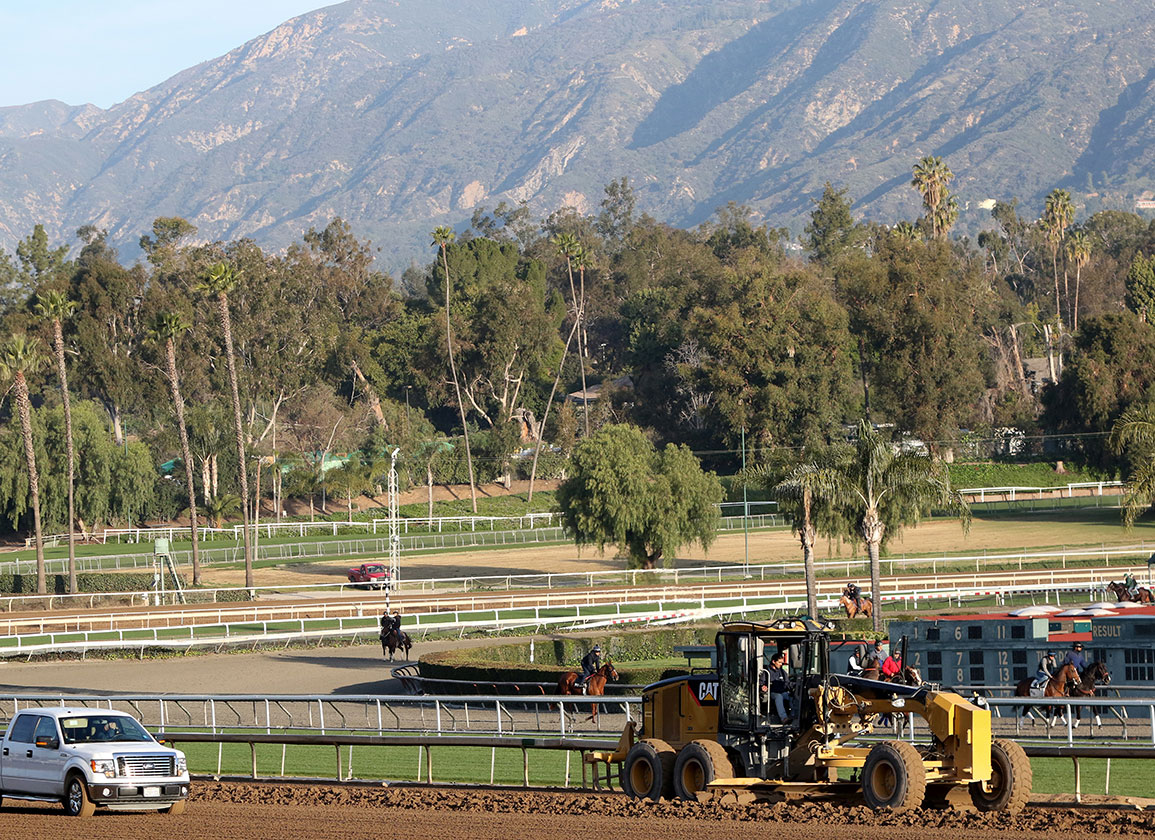By Bill Finley
After being closed since 9 a.m. Monday morning, the main track at Santa Anita re-opened Thursday and there were no incidents or reports of serious injuries during training hours. Yesterday also marked the return of racing to Santa Anita after three regularly scheduled dark days and the races were also concluded without any reported incidents.
The track has been closed so tests could be taken to see if experts could find any specific problems with the racing surface. Nineteen horses have died at Santa Anita since Dec. 26, either during races or during training hours. The most notable horse among the group was 2017 GI Breeders' Cup Dirt Mile winner Battle of Midway (Smart Strike).
The green light was given to resume training after the track was inspected by a team headed by racetrack surface expert. Mick Peterson, the director of the University of Kentucky's Agricultural Equine Program.
“Things went well during training,” Peterson said. “Everything is progressing positively and everything looks good. Santa Anita management is being proactive and they're not taking this lightly. That's when I get worried, when a track has been complacent and that isn't the case here at all.”
Retired jockey Alex Solis, who doubles and as an exercise rider and a Member of the Board of Directors of the California Horse Racing Board, echoed Peterson's sentiments.
“It went very well this morning,” Solis said.. “I thought they did a great job. I was very satisfied with the track and with the way the horses were moving this morning. We're all trying to find solutions. I worked two horses around the racetrack and I galloped two others and was very satisfied with it. At this point, you don't sense that there's anything wrong with the track. Before it was inconsistent because they had to seal the track and open it up because of all the bad weather we've had. You never know what's going to happen when that happens.”
Trainers did not appear to shy away from normal work schedules as there were 45 recorded works on the main track. Bob Baffert sent out two of his better horses. GI Starlet S. winner Chasing Yesterday (Tapit), worked six furlongs in 1:12.40 (video). Mucho Gusto (Mucho Macho Man), who is among Baffert's top contenders for the GI Kentucky Derby, also worked, going a half-mile in :47.60 (see related story).
Peterson, who has done extensive tests, has not been able to find anything wrong with the track.
“We're not seeing anything wrong,” he said. “The comparison here is what they do with the National Traffic Safety Administration. We'll put all our material together, we'll give it to the California Horse Racing Board and they'll combine that with the necropsy data. If we have an unusual pattern of injuries, that begins to raise questions about all sorts of issues that have nothing to do with the track. We have to look at everything.”
Peterson will continue to study the track over the next few days and see if he can come up with some answers as to why its condition may have led to so many fatalities. So far, he has already tested the composition of the soil and compared it to similar tests done in October. He also used what he calls “ground penetrating radar” to take and study images of the base, the cushion and the pad.
“The weather has been unusual so that makes it a lot more challenging, but we really aren't seeing anything wrong at this point,” he said.
Many believe that an unusual run of wet and cold weather might have played a role in whatever possible problems there have been with the track. Peterson agreed that could be a factor.
“One of the most important things we have to look at is moisture and how we respond with the maintenance to the rain and then the drying out,” he said. “That's all part of the puzzle that we're looking at. I think we should be fine, but until we've had a few more days of racing and training that are safe I don't think anybody is going to be complacent.”
If Peterson is not able to find any answers, perhaps the California Horse Racing Board will, as it is in the process of performing necropsies on each of the horses who have died. California State Equine Medical Director Rick Arthur said it may take as long as a month before all the necropsies are completed.
Arthur is of the opinion that pre-existing injuries are what normally lead to catastrophic breakdowns and said these sorts of problems are never just about the racetrack.
“I don't find it surprising that the track is good now,” he said. “Nobody was on it for a couple of days and we've had fairly good weather here for 10 days or so. We certainly know from past experience that it takes 10 days to two weeks for a track to get back to good condition after a hard seal. I don't want to blame the track, but I'm not going to take a position that the track was not a factor. Trainers get upset at me when I point out that 85 to 90% of the time, horses have pre-existing pathology at the site of the fatal injury. On the other hand, they want to blame the track for everything. What we really need to do is address this as an industry and use science.”
Not a subscriber? Click here to sign up for the daily PDF or alerts.






